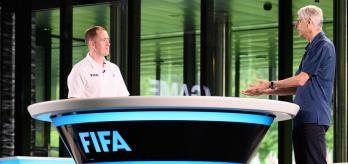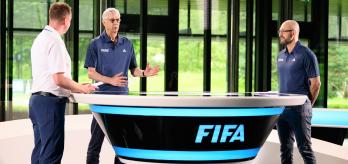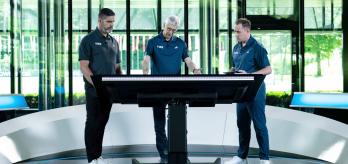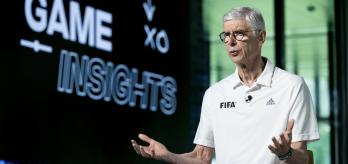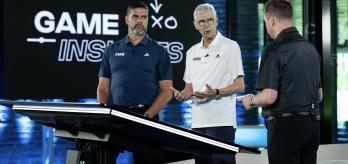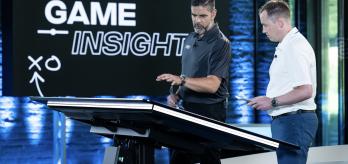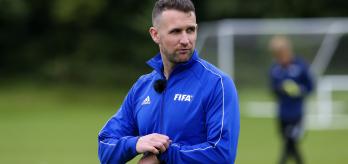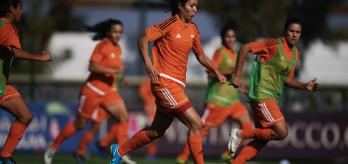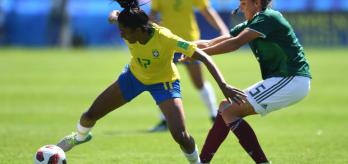In this episode of Game Insights, Chris Loxston (Group Leader, Football Performance Analysis & Insights), Arsène Wenger (Chief of Global Football Development) and Pascal Zuberbühler (Senior Football & Goalkeeping Expert) discuss Chelsea's 3-4-3 system and the main tactical aspects that were on show during their performances at the FIFA Club World Cup 2021™. They describe how the wing-backs operate in Chelsea's attacking system, how the midfielders prepare to stop counter-attacks and the distribution of their centre-backs. They then examine the opposition's tactics and how they tried to expose the weaknesses in Chelsea's system. Wenger, Loxston and Zuberbühler also analyse the goalkeepers' performances, paying particular attention to their positioning and movements when facing shots or counter-attacks.
Part 1: Introduction
00:30
The role of the wing-backs
Chelsea's objective in this 3-4-3 system is to use the full width of the pitch by allowing the wing-backs to stay wide and roam up and down the flanks. This makes it difficult for the opposition to defend against attacks, and they may need to use a back line of six players to try to stop them.
2:02
Protection from midfield
"The two central midfielders protect the centre-backs defensively. As we can see, when the full-backs play so high up, you need protection when you lose the ball. Then it's necessary to quickly put pressure on the ball and to win it back again, because the opposition are vulnerable on the flanks." (AW)
03:38
The "five channels"
The term "five channels" describes a team playing with five defenders and distributing them across the back line, with each defender being responsible for one of the five channels. The same principle applies to the attacking system, when the formation becomes a 3-2-5 and the front line comprises three strikers and the two wing-backs. The five attacking players then stretch the pitch to occupy all five channels.
07:52
Chelsea v. Al-Hilal (FIFA Club World Cup 2021 semi-final)
In this example, the Chelsea wing-backs look to move inside to become available for a pass, whereas the wingers move out wide and operate on the flanks. This switch frees up the wingers, including Hakim Ziyech, who was able to receive the ball and run at the defenders out wide. The wing-backs, César Azpilicueta and Marcos Alonso, can then attack the goal and join the centre-forward inside the penalty area, making this move difficult to defend against.
08:48
"Rest defence"
When the wingers and wing-backs are all high up the pitch, the two central midfielders stay outside the penalty area in order to deal with any potential counter-attack in the event that Chelsea lose possession. This tactic is known as "rest defence"; the idea is to mark opposition players even when Chelsea are in possession.
10:50
The modern centre-back
In the modern game, centre-backs are becoming much more useful in the opponent's half due to their increased technical ability. In this system, Chelsea's centre-backs need to push forward and join the attack so that their quality on the ball can make a difference in the final third.
Part 2: CHELSEA'S SYSTEM V. PALMEIRAS'S TACTICAL APPROACH
00:10
Palmeiras's defensive approach
To counter Chelsea's attack, Palmeiras are double-marking Romelu Lukaku. This means that the middle of the three centre-backs, Thiago Silva, is unmarked and free to pick passes and move forward. The entire Palmeiras team sets up inside their own half, with the full-backs tucking into midfield and the wing-backs dropping into the full-back positions, which leaves some space between them and the centre-backs.
01:50
Palmeiras's counter-attack
Chelsea are dominating the ball and their centre-backs are able to carry the ball forward. However, Palmeiras are waiting for an opportunity to win the ball and launch a quick counter-attack. With this in mind, they are aiming to surround Lukaku and steal the ball from him.
04:33
Errors in the defensive line
Chelsea continue to move the ball forward, with Thiago Silva able to carry it into the spaces in midfield. Because the Palmeiras wingers have taken up the full-back positions and are not used to playing there, they are not paying attention to the defensive line and are playing Lukaku onside. If Silva spots this, he can easily play him in with a ball over the top.
05:53
Thiago Silva in possession
Thiago Silva was in possession of the ball for a total of 6 minutes and 23 seconds, which shows that Palmeiras decided to allow him to have the ball, while also demonstrating his ability to distribute possession. He also received the ball 132 times, which tells you that the opposition did not block the passing lanes into him.
11:22
Exposure to counter-attacks
"I would say that this explains that the opponent dropped very deep and Chelsea had a problem with it. For them to attack very high up without being exposed to the counter-attack is always a difficulty, and that's why you need experienced players at the back to deal with that. Thiago Silva does that very well." (AW)
12:05
Chelsea's attacking issues
The average position of Chelsea's wide players was too central, and they did not consistently stretch the opposition enough. Because Thiago Silva played a lot of balls through the middle and not enough to the flanks, Palmeiras were able to congest the central areas and prevent Chelsea from creating good chances.
Part 3: CHELSEA'S MOVEMENT TO CREATE THE OPENING GOAL IN FINAL
00:10
Opening up space to attack
As the attacking midfielder, Kai Havertz, drops deep to receive the ball, he takes the right-back with him. This allows the player on the ball, central midfielder Mateo Kovačić, to accelerate past his marker and drive into space.
00:52
Coordinated movements
"Coordinated movements allow one player to pull out the defender and open spaces for somebody else to run into." (AW)
01:42
Runs into the penalty area
Once Chelsea get in behind the defence and into a crossing situation, they have five players making runs into the penalty area. This allows them to outnumber the defenders and improve their chances of scoring.
Part 4: CHELSEA'S GOALKEEPERS
00:30
The goalkeeper hierarchy
"First of all, I think you need a hierarchy between goalkeepers. You have to name a number one and a number two, knowing that it can change with bad performances. In Chelsea's situation, (Édouard) Mendy is clearly number one because he played in the final." (AW)
02:00
Kepa's positioning
Despite being unsighted, Kepa Arrizabalaga is able to make a fantastic save and prevent a goal for Al-Hilal. To help him make the save, he positions himself with his weight on his right foot, so that he can push off to his left with power and speed. He then takes a little step to his left so that he can stretch further to reach the ball.
04:17
Using the defender's movement
By using his team-mate N'Golo Kanté's body position as a clue, Kepa is able to work out the direction of the shot. Because Kanté opens his legs to the left, Kepa can anticipate where the shot is coming from and where he needs to jump to make the save.
06:15
The blocking zone
Once a goalkeeper gets into the blocking zone, it is much easier for them to make a save and much harder for the attacker to score. In this instance, if Kepa's position had been deeper, he would have struggled to make the save. Six metres from the attacker is too far away; ideally a goalkeeper should be within two to three metres.
10:05
Mendy's positioning
Because Chelsea are playing a high line and Palmeiras are looking to catch them out on the counter-attack, Mendy needs to be prepared to step out of his goal. This clip shows that Mendy is quick to sprint forward, and by stretching his legs, he is well prepared to get to the ball quickly if it is played into the space behind the defence. Once he realises he cannot get to the ball before the attacker, he holds his position and then quickly drops back so he cannot be beaten easily.
13:00
The modern goalkeeper
"What you need today from a modern goalkeeper is intelligence. They need to read the game and know what their next step is. They need to read the situation very well, and, in this situation, Mendy did that fantastically well." (PZ)








